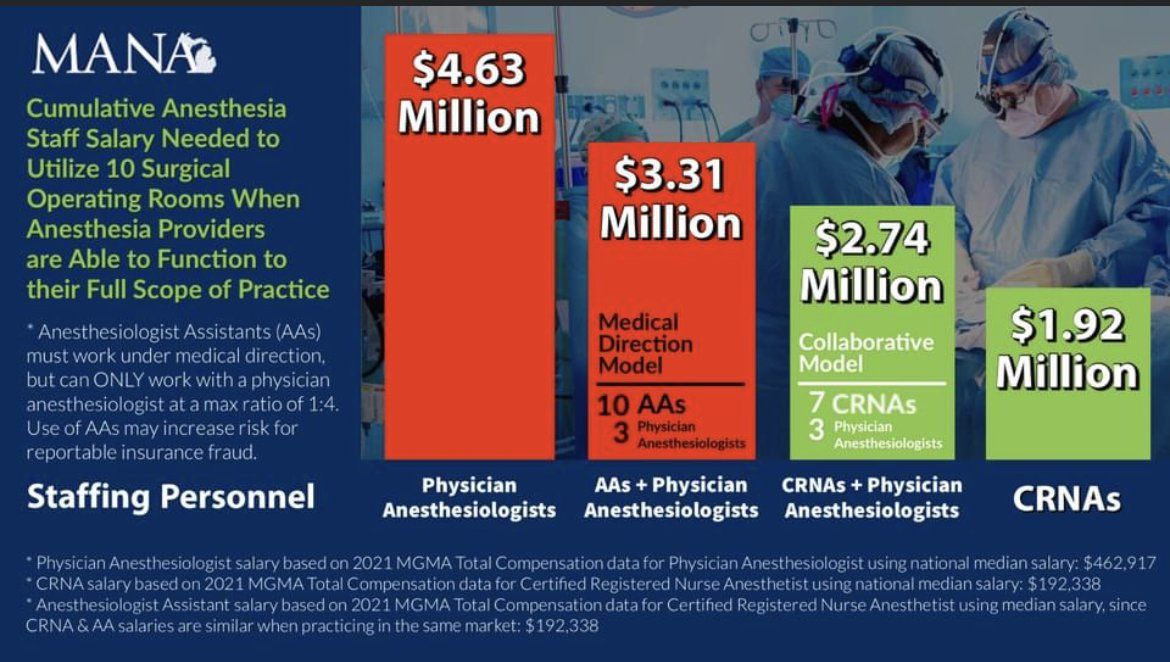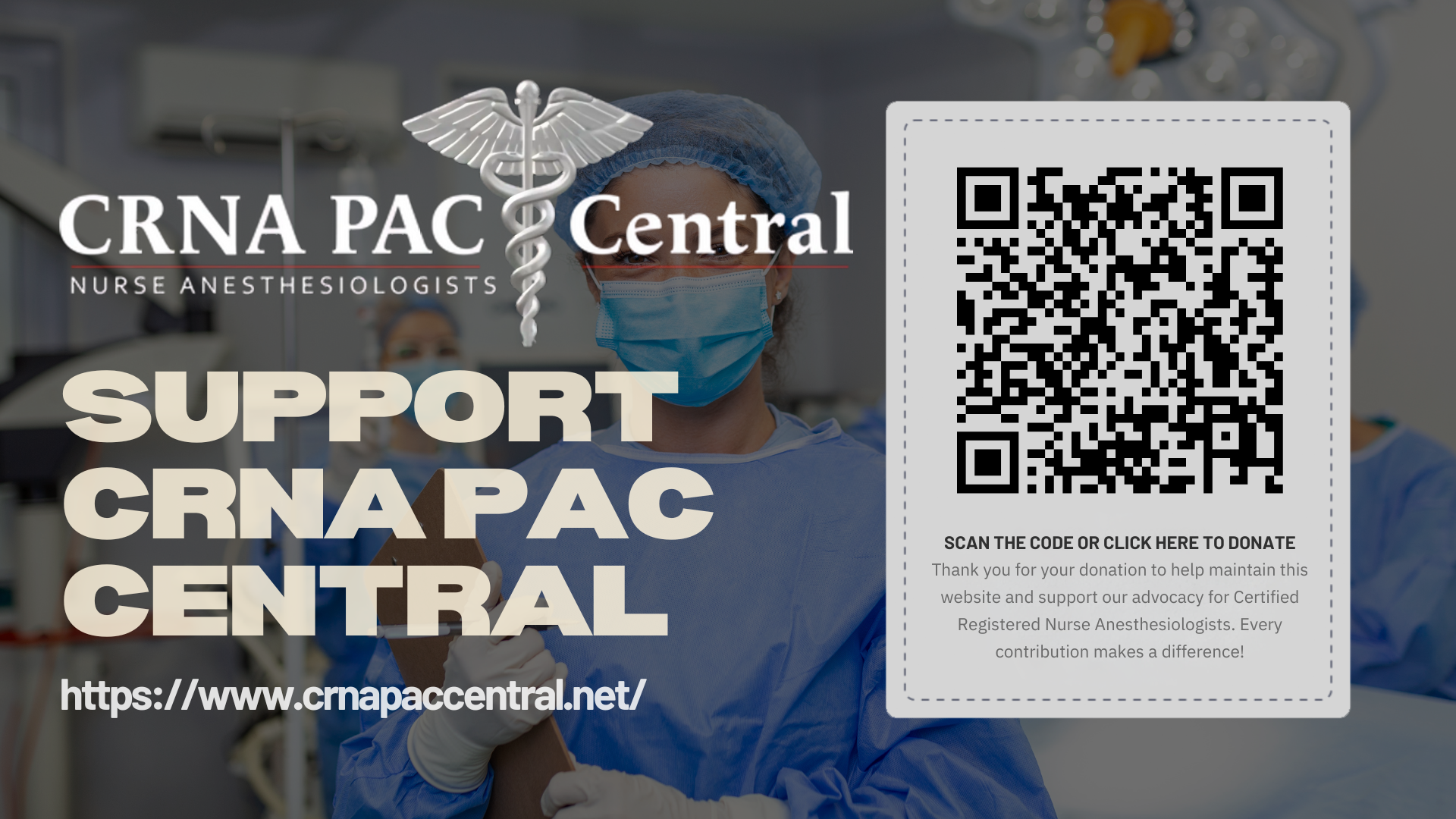CRNAs Are the Answer
The Nurse Anesthesiology profession has been in existence for 159 years. During that period of time, nurse anesthesiologists have personally delivered more than 1.4 BILLION anesthetics. No other provider has personally delivered more anesthetics than Certified Registered Nurse Anesthesiologists.
- Most Cost Efficient Provider
- Increases access to care
- Studies demonstrate NO DIFFERENCE IN OUTCOMES

Study Shows CRNA-Only Anesthesia Delivery Is Most Cost Effective Model
A Certified Registered Nurse Anesthetist (CRNA) acting as the sole anesthesia provider is the most cost effective model of anesthesia delivery, according to a new study conducted by Virginia-based The Lewin Group and published in the May/June 2010 issue of the Journal of Nursing Economics.
The study, titled “Cost Effectiveness Analysis of Anesthesia Providers,” considered the different anesthesia delivery models in use in the United States today, including CRNAs acting solo, physician anesthesiologists acting solo, and various models in which a single anesthesiologist directs or supervises one to six CRNAs. The results show that CRNAs acting as the sole anesthesia provider cost 25 percent less than the second lowest cost model. On the other end of the cost scale, the model in which one anesthesiologist supervises one CRNA is the least cost efficient model.
The study’s authors also completed a thorough review of the literature that compares the quality of anesthesia service by provider type or delivery model. This review of published studies shows that there are no measurable differences in quality of care between CRNAs and anesthesiologists or by delivery model.
“The data confirm that CRNAs deliver anesthesia safely and cost-effectively,” said AANA President James Walker, DNP, CRNA. “With growing demands on the healthcare system nationwide, we must do all we can to make sure the nation’s healthcare professionals are used as effectively and efficiently as possible. CRNAs, who administer approximately 32 million anesthetics to patients in the United States each year, stand ready to do our part.”
The results of the Lewin study were particularly compelling for people living in rural and other areas of the United States where anesthesiologists often choose not to practice for economic reasons. The safe, cost-effective anesthesia care provided by nurse anesthetists has been a mainstay in these areas for more than 100 years, ensuring millions of patients access to surgical, obstetrical, trauma stabilization, and diagnostic procedures.
Method
In order to define the most cost-effective anesthesia delivery model, the study’s authors conducted simulation modeling and claims analysis using the Ingenix national claims database of integrated medical and financial data from commercial payers for 2008, which included 52,636 anesthesia deliveries, and the 2006 National Survey of Ambulatory Surgery (NSAS) which contains 52,223 visits. Findings regarding the quality of anesthesia care were based on a comprehensive review of nine published studies.
Nursing Economics advances nursing leadership in healthcare, with a focus on tomorrow, by providing information and thoughtful analyses of current and emerging best practices in healthcare management, economics, and policymaking. The journal supports nurse leaders and others who are responsible for directing nursing’s impact on healthcare cost and quality outcomes. The journal is published six times per year.
The Lewin Group is an Ingenix company. Ingenix, a wholly-owned subsidiary of UnitedHealth Group, was founded in 1996 to develop, acquire and integrate the world’s best-in-class healthcare information technology capabilities. For more information, visit ingenix.com. The Lewin Group operates with editorial independence and provides its clients with the very best expert and impartial healthcare and human services policy research and consulting services.
CRNAs Increase Access to Care
CRNAs provide more than 50 million anesthetics annually in the United States. Nurse anesthesia services are crucial to rural healthcare. As the sole anesthesia providers in the vast majority of rural hospitals, CRNAs enable these facilities to offer surgical, obstetrical, trauma stabilization, interventional diagnostic, and pain management services.
According to the National Rural Health Association, 121 rural hospitals have closed since 2010, with more than 163 and counting closed since 2005. Right now, 673 additional facilities are vulnerable and could close, representing more than one-third of rural hospitals in the U.S.1
- https://www.ruralhealthweb.org/advocate/save-rural-hospitals
CRNAs play an essential role in ensuring that rural America has access to critical anesthesia services, often serving as the sole anesthesia provider in rural hospitals, affording these facilities the capability to provide many necessary procedures.
2. Liao CJ, Quraishi JA, Jordan, LM. Geographical Imbalance of Anesthesia Providers and its Impact on the Uninsured and Vulnerable Populations.
Nurse Econ. 2015;33(5):263-270. https://www.semanticscholar.org/paper/ Geographical-Imbalance-of-Anesthesia-Providers-and-Liao-Quraishi/77112f1f 7ca09a86142b4f5e7c065ae9a073dec2
CRNAs are uniquely trained and positioned to treat COVID-19 patients in this pandemic. All CRNAs have at least one year of experience as an RN in a critical care setting, with the average CRNA having 3 years of this experience before becoming a CRNA.
Read more about how CRNAs increase access to care by clicking the button below.
CRNAs Safely Deliver More Than 50 Million Anesthetics Annually
Numerous peer reviewed studies have shown that CRNAs are safe, high quality and cost-effective anesthesia professionals who should practice to the full extent of their education and abilities. According to a 2010 study published in the journal Health Affairs, there are similarly low rates of adverse events for CRNAs and other anesthesia providers and anesthesia delivery models. In 2016, the Cochrane Collaboration, an internationally recognized authority on evidence-based practice in healthcare, determined that there were no differences in patient outcomes when anesthesia was delivered by a nurse anesthesiologist or a physician Anesthesiologist. The study, published in Medical Care (June 2016), also found no measurable impact in anesthesia complications from either a nurse anesthetist scope of practice or practice restrictions.

